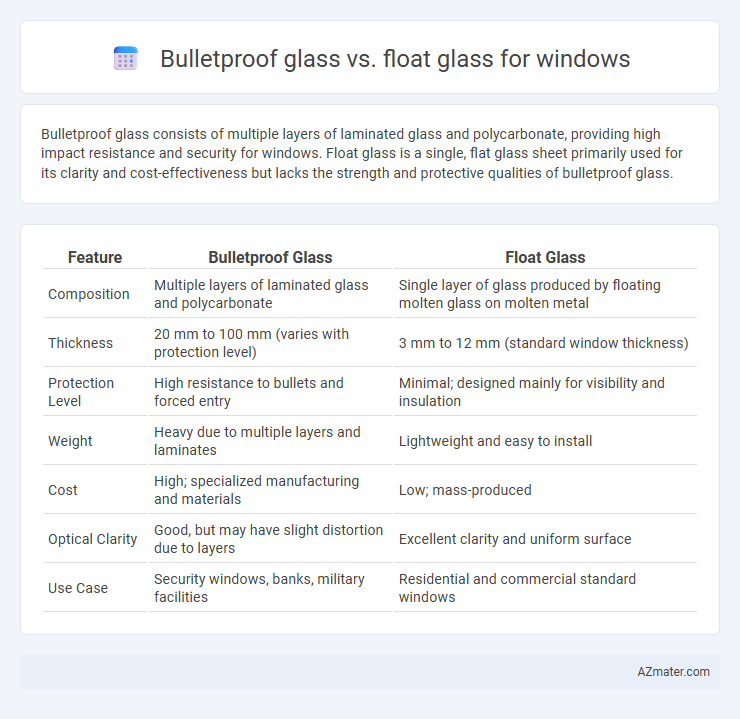Bulletproof glass consists of multiple layers of laminated glass and polycarbonate, providing high impact resistance and security for windows. Float glass is a single, flat glass sheet primarily used for its clarity and cost-effectiveness but lacks the strength and protective qualities of bulletproof glass.
Table of Comparison
| Feature | Bulletproof Glass | Float Glass |
|---|---|---|
| Composition | Multiple layers of laminated glass and polycarbonate | Single layer of glass produced by floating molten glass on molten metal |
| Thickness | 20 mm to 100 mm (varies with protection level) | 3 mm to 12 mm (standard window thickness) |
| Protection Level | High resistance to bullets and forced entry | Minimal; designed mainly for visibility and insulation |
| Weight | Heavy due to multiple layers and laminates | Lightweight and easy to install |
| Cost | High; specialized manufacturing and materials | Low; mass-produced |
| Optical Clarity | Good, but may have slight distortion due to layers | Excellent clarity and uniform surface |
| Use Case | Security windows, banks, military facilities | Residential and commercial standard windows |
Introduction: Understanding Bulletproof Glass and Float Glass
Bulletproof glass, also known as ballistic glass, is a multi-layered material designed to resist high-impact forces and provide enhanced security for windows in vehicles, buildings, and secure facilities. Float glass, a commonly used type of glass for windows, is created by floating molten glass on a bed of molten metal to achieve a smooth, uniform thickness but lacks impact resistance. Understanding the structural differences and intended applications of bulletproof glass versus float glass is crucial for selecting the appropriate material based on security needs and environmental conditions.
Composition and Manufacturing Process
Bulletproof glass, also known as laminated or ballistic glass, is composed of multiple layers of polycarbonate, glass, and interlayers like polyvinyl butyral (PVB) or ethylene-vinyl acetate (EVA) bonded under heat and pressure to achieve high impact resistance. Float glass, on the other hand, is made by floating molten glass on a bed of molten tin, producing a single flat sheet with uniform thickness and smooth surfaces. The manufacturing process of bulletproof glass involves layering and lamination for strength and shatter resistance, whereas float glass focuses on precision and clarity for architectural applications.
Strength and Durability Comparison
Bulletproof glass exhibits superior strength and durability compared to float glass due to its multi-layered construction of polycarbonate and laminated glass, designed to withstand high-impact forces and prevent penetration. Float glass, made from molten glass cooled on a bed of molten metal, lacks the reinforced structure, making it prone to shattering under strong impact or pressure. For applications requiring maximum security and resistance to breakage, bulletproof glass provides enhanced protection and longer service life compared to standard float glass.
Security Features and Protection Levels
Bulletproof glass offers superior security features compared to float glass, designed to withstand high-impact forces and prevent penetration from bullets or forced entry tools. This laminated composite structure combines multiple layers of glass and polycarbonate to provide enhanced protection levels against ballistic threats and physical attacks. In contrast, float glass lacks these reinforced properties, making it susceptible to shattering and offering minimal resistance to break-ins or projectile damage.
Applications in Residential and Commercial Settings
Bulletproof glass is ideal for residential and commercial windows requiring high security, such as banks, government buildings, and luxury homes, providing robust protection against forced entry and ballistic threats. Float glass, commonly used in standard residential and commercial windows, offers cost-effective, clear visibility and energy efficiency but lacks the impact resistance of bulletproof glass. Choosing between bulletproof and float glass depends on the specific safety needs and budget considerations of the property.
Cost Analysis: Bulletproof Glass vs Float Glass
Bulletproof glass typically costs between $25 to $50 per square foot, significantly higher than float glass, which ranges from $3 to $10 per square foot. The increased price of bulletproof glass reflects its multi-layered construction of polycarbonate and glass designed for ballistic resistance, whereas float glass is a single, flat pane suitable for standard window applications. Choosing bulletproof glass incurs substantial upfront investment but guarantees enhanced security, while float glass offers affordability for standard insulation and aesthetics.
Energy Efficiency and Insulation Properties
Bulletproof glass offers superior insulation properties compared to float glass, significantly reducing heat transfer and enhancing energy efficiency in windows. Its multi-layer construction incorporates polycarbonate or PVB interlayers that provide better thermal resistance and soundproofing. Float glass, while cost-effective and lightweight, lacks the advanced energy-saving capabilities inherent in bulletproof glass, making it less efficient for insulation purposes.
Aesthetics and Design Flexibility
Bulletproof glass offers enhanced safety without compromising on modern aesthetics, featuring a clear, polished finish that maintains visibility while providing strength. Float glass, known for its smooth and uniform surface, excels in design flexibility with easy customization options such as tinting, coating, and shaping to meet diverse architectural needs. Both materials cater to different design priorities, with bulletproof glass appealing to security-conscious projects and float glass favoring creative and cost-effective window designs.
Maintenance and Longevity
Bulletproof glass offers superior durability and resistance to impacts compared to float glass, significantly reducing the frequency of repairs and replacements, which lowers long-term maintenance costs. Float glass, while more affordable upfront, is more prone to scratches, chips, and breakage, demanding more frequent upkeep and potential replacement. The extended lifespan of bulletproof glass makes it a cost-effective investment for windows in security-sensitive environments where longevity and minimal maintenance are critical.
Choosing the Right Glass for Your Windows
Bulletproof glass offers superior security and impact resistance compared to float glass, making it ideal for high-risk locations or protective installations. Float glass, widely used in residential and commercial windows, provides clarity and affordability but lacks the durability needed to withstand forced entry or extreme impacts. Selecting the right glass depends on balancing factors such as security requirements, budget constraints, and window usage to ensure optimal protection and performance.

Infographic: Bulletproof glass vs Float glass for Window
 azmater.com
azmater.com